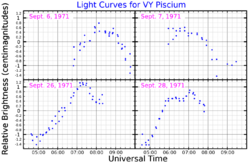Astronomy:HR 515
 Light curves for VY Piscium, adapted from Valtier et al. (1974).[1] The vertical scale is hundredths of a magnitude. | |
| Observation data Equinox J2000.0]] (ICRS) | |
|---|---|
| Constellation | Pisces |
| Right ascension | 01h 46m 35.29855s[2] |
| Declination | +17° 24′ 45.7125″[2] |
| Apparent magnitude (V) | 6.54 - 6.59[3] |
| Characteristics | |
| Spectral type | A8 III[4] or F0V[5] |
| B−V color index | 0.256±0.010[6] |
| Variable type | δ Sct[7] |
| Astrometry | |
| Radial velocity (Rv) | −1.0±4.4[8] km/s |
| Proper motion (μ) | RA: +49.315[2] mas/yr Dec.: +3.096[2] mas/yr |
| Parallax (π) | 6.4827 ± 0.1220[2] mas |
| Distance | 503 ± 9 ly (154 ± 3 pc) |
| Absolute magnitude (MV) | +0.84[6] |
| Details | |
| Mass | 1.7[9] M☉ |
| Radius | 4.7[9] R☉ |
| Luminosity | 60[9] L☉ |
| Surface gravity (log g) | 3.32[9] cgs |
| Temperature | 7,401[9] K |
| Metallicity [Fe/H] | −0.02[10] dex |
| Rotational velocity (v sin i) | 96[11] km/s |
| Age | 944[10] Myr |
| Other designations | |
| Database references | |
| SIMBAD | data |
HR 515 is a variable star in the zodiac constellation of Pisces, near the eastern constellation border with Aries. Before the constellation borders were officially set, it held the Flamsteed designation of 3 Arietis, abbreviated 3 Ari). This star has the variable star designation VY Piscium, or VY Psc for short.[13] It is a white-hued star that is near the lower limit of visibility to the naked eye with an apparent visual magnitude that ranges from 6.54 down to 6.59.[3] Parallax measurements provide a distance estimate of approximately 503 light years from the Sun.[2]
Gray and associates (1989) found a stellar classification of A8 III[4] for this object, matching an evolved A-type giant star. Abt and Morrell (1995) listed a class of F0V,[5] suggesting it is an F-type main-sequence star. It is a Delta Scuti variable whose brightness varies between magnitudes 6.54 and 6.59[3] with a period of 0.219 days.[7] The star shows a high rate of spin with a projected rotational velocity of 96 km/s.[11] It has 4.7 times the girth of the Sun and is radiating 60 times the Sun's luminosity from its photosphere at an effective temperature of 7,401 K.[9]
References
- ↑ Valtier, J. C.; Sareyan, J. P.; Le Contel, J. M.; Zribi, G. (January 1974). "Photometric observations of delta Scuti stars. II. HR 432, HR 515, HR 812". Astronomy and Astrophysics Supplement Series 18: 235–249. Bibcode: 1974A&AS...18..235V.
- ↑ 2.0 2.1 2.2 2.3 2.4 2.5 Vallenari, A. et al. (2022). "Gaia Data Release 3. Summary of the content and survey properties". Astronomy & Astrophysics. doi:10.1051/0004-6361/202243940 Gaia DR3 record for this source at VizieR.
- ↑ 3.0 3.1 3.2 "VY Psc". VSX: The International Variable Star Index. American Association of Variable Star Observers. http://www.aavso.org/vsx/index.php?view=detail.top&oid=26439.
- ↑ 4.0 4.1 Gray, R. O.; Garrison, R. F. (July 1989). "The Late A-Type Stars: Refined MK Classification, Confrontation with Stroemgren Photometry, and the Effects of Rotation". Astrophysical Journal Supplement 70: 623. doi:10.1086/191349. Bibcode: 1989ApJS...70..623G.
- ↑ 5.0 5.1 Abt, Helmut A.; Morrell, Nidia I. (1995). "The Relation between Rotational Velocities and Spectral Peculiarities among A-Type Stars". Astrophysical Journal Supplement 99: 135. doi:10.1086/192182. Bibcode: 1995ApJS...99..135A.
- ↑ 6.0 6.1 Anderson, E.; Francis, Ch. (2012), "XHIP: An extended hipparcos compilation", Astronomy Letters 38 (5): 331, doi:10.1134/S1063773712050015, Bibcode: 2012AstL...38..331A.
- ↑ 7.0 7.1 Rodríguez, E.; López-González, M. J.; López de Coca, P. (June 2000). "A revised catalogue of delta Sct stars". Astronomy and Astrophysics Supplement 144 (3): 469−474. doi:10.1051/aas:2000221. Bibcode: 2000A&AS..144..469R.
- ↑ de Bruijne, J. H. J.; Eilers, A.-C. (October 2012). "Radial velocities for the HIPPARCOS-Gaia Hundred-Thousand-Proper-Motion project". Astronomy & Astrophysics 546: 14. doi:10.1051/0004-6361/201219219. A61. Bibcode: 2012A&A...546A..61D.
- ↑ 9.0 9.1 9.2 9.3 9.4 9.5 Stassun, Keivan G. et al. (9 September 2019). "The Revised TESS Input Catalog and Candidate Target List". The Astronomical Journal 158 (4): 138. doi:10.3847/1538-3881/ab3467. ISSN 0004-6256. Bibcode: 2019AJ....158..138S.
- ↑ 10.0 10.1 Gontcharov, G. A. (December 2012). "Dependence of kinematics on the age of stars in the solar neighborhood". Astronomy Letters 38 (12): 771–782. doi:10.1134/S1063773712120031. ISSN 1063-7737. Bibcode: 2012AstL...38..771G.
- ↑ 11.0 11.1 Royer, F. et al. (October 2002). "Rotational velocities of A-type stars in the northern hemisphere. II. Measurement of v sin i". Astronomy and Astrophysics 393: 897–911. doi:10.1051/0004-6361:20020943. Bibcode: 2002A&A...393..897R.
- ↑ "V* VY Psc". SIMBAD. Centre de données astronomiques de Strasbourg. http://simbad.u-strasbg.fr/simbad/sim-basic?Ident=V%2A+VY+Psc.
- ↑ "VY Psc (VY Piscium)". VSNET. http://www.kusastro.kyoto-u.ac.jp/vsnet/gcvs2/PSCVY.html.
Coordinates: ![]() 01h 46m 35.29944s, +17° 24′ 45.7133″
01h 46m 35.29944s, +17° 24′ 45.7133″
 |

